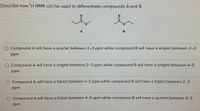
Chemistry
10th Edition
ISBN: 9781305957404
Author: Steven S. Zumdahl, Susan A. Zumdahl, Donald J. DeCoste
Publisher: Cengage Learning
expand_more
expand_more
format_list_bulleted
Concept explainers
Question
Pls help ASAP, thanks!
"describe how 1H NMR can be used to differentiate compounds A & B"

Transcribed Image Text:Describe how 'H NMR can be used to differentiate compounds A and B.
Compound A will have a quartet between 2-3 ppm while compound B will have a singlet between 2-3
ppm
O Compound A will have a singlet between 2-3 ppm while compound B will have a singlet between 4-5
udd
Compound A will have a triplet between 1-2 ppm while compound B will have a triplet between 2-3
ppm
Compound A will have a triplet between 4-5 ppm while compound B will have a quartet between 4-5
ppm
A.
Expert Solution
This question has been solved!
Explore an expertly crafted, step-by-step solution for a thorough understanding of key concepts.
Step by stepSolved in 2 steps with 1 images

Knowledge Booster
Learn more about
Need a deep-dive on the concept behind this application? Look no further. Learn more about this topic, chemistry and related others by exploring similar questions and additional content below.Similar questions
- How many ¹H NMR signals are present in the product of the reaction shown below? O O 00 9 1) CH3MgCI 2) H₂Oarrow_forward3. A student performed the following reaction and obtained a product with a chemical formula of C6H120. Use the chemical formula and 'H NMR spectrum to determine the structure of the product. (No peaks exchange with D20). Then propose a mechanism for the reaction. H* / H20 OH но singlet 1= 6 triplet |= 2 quintet | = 2 triplet |= 2 4.0 3.0 2.0 1.0 0.0 8 (ppm) Mechanism:arrow_forwardCan I have help with this question?arrow_forward
- Give clear detailed Solution with explanation needed..please avoid handwritten Solutionarrow_forwardCan i get help with these problemsarrow_forwardLabel each set of chemically equivalent protons, using a for the set that will be at the lowest frequency in the 1H NMR spectrum, A. for the next lowest, and so on. Indicate the multiplicity of each signal.arrow_forward
- is the product supposed to be 2- methyl-3-pentanol?arrow_forward14. Propose structure for a compound, C9H₁1Br that fits the following ¹H NMR data: 2.15 8 (2H, quintet) 2.75 8 (2H, triplet) 3.38 8 (2H, triplet) 7.22 8 (5H, singlet)arrow_forwarddraw the ethanol strcture and then circle the protons on the structures and correlate the 1H's to the resonances (peaks) on the 1H NMR spectra.arrow_forward
arrow_back_ios
arrow_forward_ios
Recommended textbooks for you
 ChemistryChemistryISBN:9781305957404Author:Steven S. Zumdahl, Susan A. Zumdahl, Donald J. DeCostePublisher:Cengage Learning
ChemistryChemistryISBN:9781305957404Author:Steven S. Zumdahl, Susan A. Zumdahl, Donald J. DeCostePublisher:Cengage Learning ChemistryChemistryISBN:9781259911156Author:Raymond Chang Dr., Jason Overby ProfessorPublisher:McGraw-Hill Education
ChemistryChemistryISBN:9781259911156Author:Raymond Chang Dr., Jason Overby ProfessorPublisher:McGraw-Hill Education Principles of Instrumental AnalysisChemistryISBN:9781305577213Author:Douglas A. Skoog, F. James Holler, Stanley R. CrouchPublisher:Cengage Learning
Principles of Instrumental AnalysisChemistryISBN:9781305577213Author:Douglas A. Skoog, F. James Holler, Stanley R. CrouchPublisher:Cengage Learning Organic ChemistryChemistryISBN:9780078021558Author:Janice Gorzynski Smith Dr.Publisher:McGraw-Hill Education
Organic ChemistryChemistryISBN:9780078021558Author:Janice Gorzynski Smith Dr.Publisher:McGraw-Hill Education Chemistry: Principles and ReactionsChemistryISBN:9781305079373Author:William L. Masterton, Cecile N. HurleyPublisher:Cengage Learning
Chemistry: Principles and ReactionsChemistryISBN:9781305079373Author:William L. Masterton, Cecile N. HurleyPublisher:Cengage Learning Elementary Principles of Chemical Processes, Bind...ChemistryISBN:9781118431221Author:Richard M. Felder, Ronald W. Rousseau, Lisa G. BullardPublisher:WILEY
Elementary Principles of Chemical Processes, Bind...ChemistryISBN:9781118431221Author:Richard M. Felder, Ronald W. Rousseau, Lisa G. BullardPublisher:WILEY

Chemistry
Chemistry
ISBN:9781305957404
Author:Steven S. Zumdahl, Susan A. Zumdahl, Donald J. DeCoste
Publisher:Cengage Learning

Chemistry
Chemistry
ISBN:9781259911156
Author:Raymond Chang Dr., Jason Overby Professor
Publisher:McGraw-Hill Education

Principles of Instrumental Analysis
Chemistry
ISBN:9781305577213
Author:Douglas A. Skoog, F. James Holler, Stanley R. Crouch
Publisher:Cengage Learning

Organic Chemistry
Chemistry
ISBN:9780078021558
Author:Janice Gorzynski Smith Dr.
Publisher:McGraw-Hill Education

Chemistry: Principles and Reactions
Chemistry
ISBN:9781305079373
Author:William L. Masterton, Cecile N. Hurley
Publisher:Cengage Learning

Elementary Principles of Chemical Processes, Bind...
Chemistry
ISBN:9781118431221
Author:Richard M. Felder, Ronald W. Rousseau, Lisa G. Bullard
Publisher:WILEY